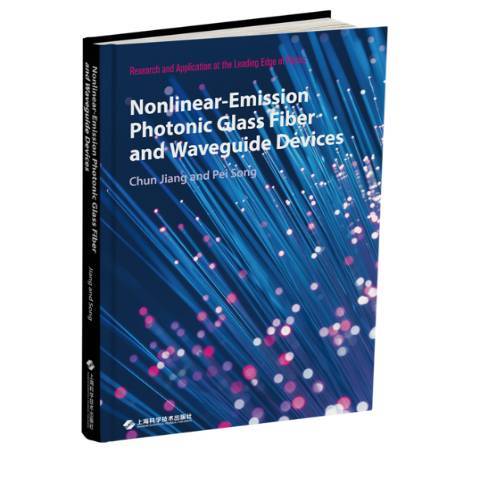《非線性發射光子玻璃光纖波導器件》是2019年上海科學技術出版社出版的圖書,作者是姜淳,宋培。
基本介紹
- 中文名:非線性發射光子玻璃光纖波導器件
- 作者:姜淳,宋培
- 出版社:上海科學技術出版社
- 出版時間:2019年10月
- 開本:16 開
- 裝幀:精裝
- ISBN:9787547845615
內容簡介,圖書目錄,作者簡介,
內容簡介
本書系統、全面地總結了國內外在稀土離子多重摻雜光子玻璃中發光離子的相互作用方面的*成果,介紹了各類摻雜材料的概念、非線性發光功能效應、研究與開發現狀、套用領域、存在的問題及其發展方向。內容包括新型摻雜材料和多稀土共摻雜材料的光譜性質計算、相互作用的理論模型、在光電子器件和光通信系統與網路等中的套用,涉及所有的稀土和過渡金屬離子的光譜性質,覆蓋面非常廣。
圖書目錄
1Fundamental Mathematics of Nonlinear Emission Photonic Glass Fiber and Waveguide Devices1
1.1Introduction1
1.2Newton Iteration Algorithm for Nonlinear Rate Equation Solution1
1.2.1SingleVariable1
1.2.2MultiVariable3
1.3RungeKutta Algorithm for PowerPropagation Equation Solution4
1.3.1SingleFunction4
1.3.2MultiFunctions6
1.4TwoPoint Boundary Problem for PowerPropagation Equations in a Laser Cavity7
1.4.1Principle7
1.4.2Shooting Method and Relaxation Method7
References92Fundamental Spectral Theory of Photonic Glasses10
2.1Introduction10
2.2JuddOfelt Theory10
2.3Transition Probability and Quantum Efficiency12
2.4Fluorescence Branch Ratio13
2.5Homogeneous and Inhomogeneous Broadening of Spectra14
References153Spectral Properties of YtterbiumDoped Glasses16
3.1Introduction16
3.2Formation Region of Yb2O3Containing Glasses16
3.3Laser Performance Parameters of YtterbiumDoped Glasses17
3.3.1Minimum Fraction of Excited State Ions17
3.3.2Saturation Pump Intensity18
3.3.3Minimum Pump Intensity18
3.3.4StorageEnergy and Gain Parameters18
3.4Spectral Properties of Yb3+Doped Borate Glasses19
3.4.1Compositional Dependence of Spectral Properties19
3.4.2Dependence of Spectral Properties on Active Ion Concentration22
3.5Spectral Properties of Yb3+Doped Phosphate Glasses23
3.5.1Compositional Dependence of Spectral Properties23
3.5.2Dependence of Spectral Properties on Active Ion Concentration26
3.6Spectral Properties of Yb3+Doped Silicate Glasses28
3.6.1Compositional Dependence of Spectral Properties28
3.6.2Dependence of Spectral Properties on Active Ion Concentration32
3.7Spectral Properties of Yb3+Doped Germanate Glasses34
3.8Spectral Properties of Yb3+Doped Telluride Glasses36
3.8.1Compositional Dependence of Spectral Properties36
3.8.2Dependence of Spectral Properties on Active Ion Concentration39
3.9Dependence of Spectral Property and Laser Performance Parameters on Glass System43
3.9.1Dependence of Spectral Property on Glass Systems43
3.9.2Dependence of Laser Performance Parameters on Glass Systems46
3.10Dependence of EnergyLevel Structure of Yb3+ on Glass Systems51
3.11Cooperative Upconversion of Yb3+ Ion Pairs53
3.11.1Cooperative Upconversion Luminescence53
3.11.2ConcentrationQuenching Mechanics57
3.11.3Concentration Dependence of Luminescence Intensity59
3.12Fluorescence Trap Effect of Yb3+ Ions in Glasses60
References634Compact Fiber Amplifiers65
4.1Introduction65
4.2Level Structure and Numerical Model66
4.3Dependence of Gain and Noise Figure on Concentrations67
4.4Doping Concentrations with ShortLength High Gain71
References725Photonic Glass Fiber Lasers74
5.1Introduction74
5.2Fundamental Physics of Fiber Laser74
5.2.1Lasing Conditions of Laser74
5.2.2Threshold Gain75
5.2.3Phase Condition and Laser Modes76
5.2.4Population Inversion Calculation76
5.3Numerical Models of RareEarthDoped Fiber Lasers80
5.3.1Configuration and PowerPropagation Equations of Fiber Laser80
5.3.2Output Power of a TwoLevel Fiber Laser81
5.3.3Output Power of a ThreeLevel Fiber Laser83
5.3.4Output Power of a FourLevel Fiber Laser84
5.3.5Output Power of Yb3+Doped Fiber Laser85
References906Broadband Fiber Amplifiers and Sources91
6.1Introduction91
6.2Pr3+Tm3+Er3+CoDoped Fiber System92
6.2.1General Rate and PowerPropagation Equations with Two Wavelength Pumps92
6.2.2Gain Characteristics with 980nm Pump96
6.2.3Gain Characteristics with 793nm Pump99
6.2.4Gain Characteristics with Double Pumps105
6.3Gain Characteristics of Pr3+Er3+CoDoped Fiber System131
6.3.1Rate and PowerPropagation Equations131
6.3.2Dependence of Gain on Fiber Parameters134
6.4WDM Transmission System Cascaded with Tm3+Er3+CoDoped Fiber Amplifiers139
6.4.1WDM System with Single Pump140
6.4.2WDM System with Dual Pumps141
References1437Photonic Glass Waveguide for Spectral Conversion145
7.1Introduction145
7.2Theoretical Model and Spectral Characterization 146
7.2.1Theoretical Model 146
7.2.2Spectral Characterization 148
ContentsixxContents7.3DoublyDoped System 148
7.3.1Energy Transfer Model 149
7.3.2Quantum Efficiency of Photonic Glass Waveguide 152
7.4TriplyDoped System 159
7.4.1Energy Transfer Model 159
7.4.2Quantum Efficiency of Photonic Glass Waveguide 163
7.5Performance Evaluation of scSiSolar Cell with Photonic Glass Waveguides 171
References1748Photonic Glass Waveguide for WhiteLight Generation177
8.1Introduction 177
8.2WhiteLight Glasses 178
8.2.1Tm3 Tb3 Eu3 CoDoped System 178
8.2.2Yb3 Er3 Tm3 CoDoped System 185
8.3EmissionTunable Glasses194
8.3.1Tb3 Sm3 Dy3 CoDoped System 194
8.3.2Tm3 Yb3 Ho3 CoDoped System 205
References214Appendix 1Matlab Code for Solving Nonlinear Rate and Power Propagation Equation
Groups in Co Doped Fiber Amplifiers or Fiber Sources219
A1.1Nonlinear Rate Equation Group and Coupled PowerPropagation
Equation Group of a ThreeActive IonsCoDoped System219
A1.2Code for Solving Linear Rate Equation Group220
A1.3Code for Solving Nonlinear Rate Equation Group220
A1.4Code for Variation of Gain with Fiber Length222
A1.5Code for Variation of Gain with Active Ion Concentration223Appendix 2Matlab Code for Solving PowerPropagation Equations of a Laser
Cavity with FourLevel System225Index228
作者簡介
姜淳,上海交通大學電子信息與電氣工程學院電子工程系教授。2005.10-2006.11: 美國麻省理工學院(MIT)電子學研究實驗室(RLE)和物理系高級研究學者。從事光電子材料與器件的研究近20年,發表SCI學術論文100餘篇, SCI他引500餘次;發明專利10餘項;2007年獲得*自然科學一等獎,2009年獲得上海自然科學三等獎。

